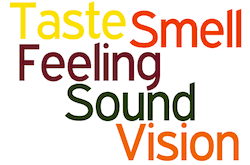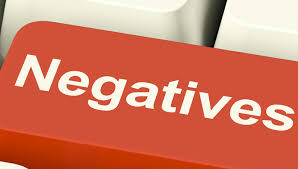The best way to supercharge the effectiveness of your ad copy, sales letters, or any advert is to engage your audience’s five senses. The more you can create a visual, emotional experience for your prospects through your advertising the more effective your marketing campaigns and sales copy will be.
How do you achieve this? By using descriptive words which appeal to the five senses and engage them.
In NLP, these are known as “representational systems” because they are how we decode, experience, and form representations of the world around us.
The representational systems
V – Visual – Seeing
A – Auditory – Hearing
K – Kinesthetic – Touching/Feeling
O – Olfactory – Smelling
G – Gustatory – Tasting
These representational systems are like windows through which we view the world and take in, and process information. They act as filters.
Some people have natural preferences for one representational system over another.
Preferred representational system
Everyone has a preferred representational system that they default to using.
Visual preference:
The vast majority of people can be described as visual people, meaning that they process things on a predominantly visual basis. These people will also tend to use visual language such as:
“I see what you mean”
“I see the big picture.”
“I like your vision for the company”
Auditory preference:
Some people are more auditory, which means they process things predominantly through the auditory sense. Auditory people tend to use language that reflects their preference such as:
“I hear what you’re saying.”
“That sounds like a great idea”
“I don’t like the sound of that”
Kinesthetic preference:
Kinesthetic people will use feeling words such as:
“This doesn’t feel right to me”
“I felt my idea was the strongest”
That sounds like a solid plan”
Visual and auditory are the most commonly preferred representational systems, but people are generally a mix of all.
Make sure your copy engages the senses
Everyone is different, and in order for your marketing messages to be effective it’s important that you cater for all the representational systems. When you use descriptive words that engage the representational systems your copy will be much more effective.
Example:
Compare the following two descriptions of chocolate.
Number 1: “Our milk chocolate tastes great. The recipe has been in our family for 100 years. Buy it now.”
Number 2: “Our milk chocolate is made from our traditional family recipe that dates back over 100 years. Each bar contains only the finest ingredients, lovingly picked by hand.
We use the finest roasted cocoa beans from fair trade farms in Madagascar. We use only the freshest milk from our free range cows raised on our very own luscious green farm.
We use pure sugarcane from the sun-drenched tropical island of Seychelles.
All of these ingredients are churned together using our traditional chocolate making technique and recipe that has been preserved in our family for over 100 years, passed down from one generation to the next.
This makes our chocolate velvety smooth. It melts in your mouth whilst the deep, rich flavours spill over your tongue, exciting your taste buds.”
After reading both descriptions which chocolate do you want to buy? Copy number 2 uses more descriptive words which engage the senses and help to paint a clearer mental movie of the experience of eating our chocolate, and also the process it goes through in creation.
Words like smooth, velvety, and luscious help to create a mental movie in your prospect’s mind. These sorts of words make it easy for your prospect to visualize themselves eating the chocolate. They can imagine what the chocolate feels like when they place a bit in their mouth, they can almost taste it as it melts on their tongue.
When you do this correctly your prospects should literally start salivating whilst reading your ad.
Get creative with your words
These sort of sensory descriptive words make it easier for your prospects to imagine themselves already using and enjoying your product or service, and once you can achieve that the chances of them actually buying your product or service increases dramatically.
This is how you can take a dull, uninspiring copy and turbocharge its effectiveness. Paint vivid, colourful pictures for your prospects via your sales copy. Try to use a mixture of words that stimulate each sense. Use words to describe how your product looks, feels, sounds, tastes, and smells (if applicable).
Even if you’re not selling an edible product you can still use some of these representational systems.
Example:
“When you sit inside the new Rolls Royce you can feel the luxurious comfort of our real leather seats. That rich smell of genuine leather and the smooth touch of the leather-encased steering wheel makes you instantly feel like a king on the road.”
See how and where you can apply the right words and engage the senses as appropriate for your product or service.
Create a list of words for your product or service
Write down all the words that come to mind when you think of your product or service. You can ask yourself some of the following questions to help you compile a list of words you want to use:
- What does your product or the result it gives your customer look like?
- How does using it make your customer feel?
- Are there any sort of distinct smells? (genuine leather, roasted beans etc)
- What does it taste like? (for edible food products)
- What sort of sound does it make?
Use the representational systems that are most relevant and applicable to your product or service. With your copy, you are directing a mental movie in your prospect’s mind. You are taking them on a descriptive journey of your product or service, so make it an exciting one!
Practice and keep learning
In order to get better at copywriting and being able to write effective sales copy or ads, you must practice.
Don’t try to get your copy perfect in your first draft, just get your ideas on paper and refine them using some of the ideas in this post and some of the other great articles we have written. Practice makes perfect, so keep at it.
Check out our post which will help you to write better sales copy like a pro. If you want to really learn the art of copywriting then you need to study the greats. Check out my list of top copywriting books every marketer should read and own.
Practice makes perfect, so keep writing and keep testing to see what works.




